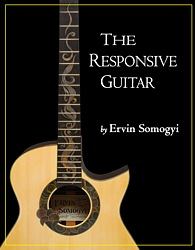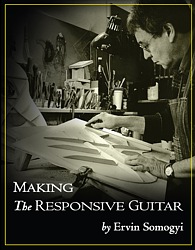These books began as a simple how-to-build-a-guitar project back in 2001. Eight years later it has grown into a two-volume dissertation on the guitar, based in forty years of my hands-on experience and thought. For more on the story of this project, read My Adventures in Book Publishing.
CLICK HERE for ordering information.
 VOLUME ONE: THE RESPONSIVE GUITAR
VOLUME ONE: THE RESPONSIVE GUITAR
This book is about the fine points of making a successful guitar. It is 350 pages long, spread out among 34 chapters on every segment and function of the guitar. It is about how, how much, and under what conditions the guitar makes sound. This includes materials analysis, theory of guitar acoustics and dynamics, a great deal of empirical information, an explanation of vibrating plate behaviors and the acoustic functions of the guitar’s principal vibrational modes, comparative and technical data, and historical perspective.
There is nothing in the market or on bookshelves like this: this book is more or less a bible for guitar makers: it contains everything I’ve learned about making guitars over a forty-plus year career. For icing on the cake, there is a 32-color-page section showing some of the most innovative and noteworthy work being done today that I know of. There are close to 500 photographs and diagrams, and everything is described in plain, everyday language: there’s not a single scientific formula anywhere.
SAMPLE CHAPTER | CLICK TO ORDER
TABLE OF CONTENTS
SECTION 1: ABOUT THE GUITAR, ITS MAKERS, AND THE AUTHOR
1. About the author
2. The differences between handmade vs. factory made guitars
3. About data and record keeping
4. Wood as a material
SECTION 2: THE PRINCIPLES THAT REGULATE THE BEHAVIORS OF THE SOUNDBOX
5. Dynamics of the guitar
6. The functions of the bracing in the modern guitar
7. Materials stiffness
8. The “X” brace
9. Other bracing systems: an overview
10. Tonewoods in guitars
11. On the selection and treatment of bracewoods
12. The basics of guitar design
13. The design and physics of the guitar’s neck and head
14. The functions of the guitar back
15. On the problems of intonation
16. Twelve-fret vs. fourteen-fret guitars
17. The guitar bridge
18. A rational approach to voicing the soundbox
19. Further dimensions and concerns of voicing
20. The dynamic importance of the soundhole
21. Acoustics and electronics
22. Ornamentation
23. Guitar cutaways
24. Domed vs. flat face construction
25. Joinery, and the neck’s attachment
26. Action, setup, and playability
SECTION 3: ENDGAME CONCERNS, OVERVIEWS, AND AFTERTHOUGHTS
27. On the mechanisms of sustain
28. On the mechanisms of projection
29. On playing-in and settling-in
30. Toward a common vocabulary for sound
31. Finishing
32. The specific challenges of making steel string vs. Spanish guitars
33. The flamenco guitar
34. Odds, ends, leftovers, and afterthoughts
The Responsive Guitar will stand on its own in spite of the fact that there’s not room in it to include much of the basic nuts-and-bolts hands-on information that a book on instrument making might be expected to contain. That information is found in the other half of my divided manuscript, Making the Responsive Guitar. I strongly recommend it to the reader who is interested in a fuller account of the mechanics and techniques of how this remarkable instrument is, was, and can be made.
 VOLUME TWO: MAKING THE RESPONSIVE GUITAR
VOLUME TWO: MAKING THE RESPONSIVE GUITAR
This is a book about understanding and making the guitar as I know it, practice it, think about it, and appreciate it. It is a comprehensive method, covering material that other books stint on or skip over entirely, including comparative perspectives on other makers’ methods. It emphasizes making the steel string guitar but also touches heavily on making the Spanish guitar
This book is hard cover, 300 pages long, and contains almost 500 photographs and diagrams. The methods and procedures described in it are based in the principles outlined in the first volume.
SAMPLE CHAPTER | CLICK TO ORDER
TABLE OF CONTENTS:
1. The principal versions of the guitar today
2. The tools
3. The sharpening and use of basic hand tools
4. Molds, jigs and workboards
5. Wood treatment and storage
6. The importance of humidity control
7. Wood dust
8. Glues and adhesives
9. Constructing the face
10. The soundhole & its reinforcement
11. The rosette
12. Making the back
13. Making the head, neck and heel
14. The sides
15. The blocks and the linings
16. The rim assembly
17. Body assembly
18. The guitar’s interior
19. Bindings, purflings and their channels
20. Gluing the bindings and purflings
21. Butt inlays and cutaway joinery
22. Neck alignment and attachment
23. Making the fingerboard, and the correct treatment of the fretboard and frets
24. Gluing the fingerboard and heelcap
25. Fretting
26. Making the bridge, its proper placement, and its correct setup
27. Action, setup, playability, and intonation
28. The pickguard and truss rod cover
29. French polishing
30. On Mistakes
31. Evaluating your guitar
32. Marketing your work
A FEW ADDITIONAL OBSERVATIONS
I have power tools for doing my work, of course, but I do an awful lot of my work with hand tools even this late in my career, and this is part of the methodologies that I explain. Finally, this book gives more detailed information about the specific tasks and skills of making a guitar both playable and playing in tune, than other texts on lutherie do.
One thing that makes these books unique, besides the wealth of primary information, is that the texts contain lots of secondary information in the form of endnote references (these have their own section in the back; ‘footnotes’ are things that appear at the bottoms of pages). The endnotes are commentaries, in-depth explanations of something that I didn’t want to interrupt the main narrative with, supplementary and alternative perspectives, personal anecdotes that are relevant to making a point, historical notes, comparative information about how someone else does this or that, and also ancillary information that, while not strictly necessary to know about, makes a given point or perspective more fully fleshed out and interesting.
These secondary commentaries are lengthy and complete enough to represent almost entire books of their own, right alongside the main text. The reader can therefore go directly through the text the first time and get the main points, and then go through it a second time to get the fuller story by reading the endnotes. Or he or she can go through more slowly and get all the information at once, sequentially. From all the feedback I’ve gotten so far from everyone who’s helped me edit and proofread these books, the main reaction seems to be that these books’ informational/presentational structure is unique, stimulating, and hard to put down once one starts to read.